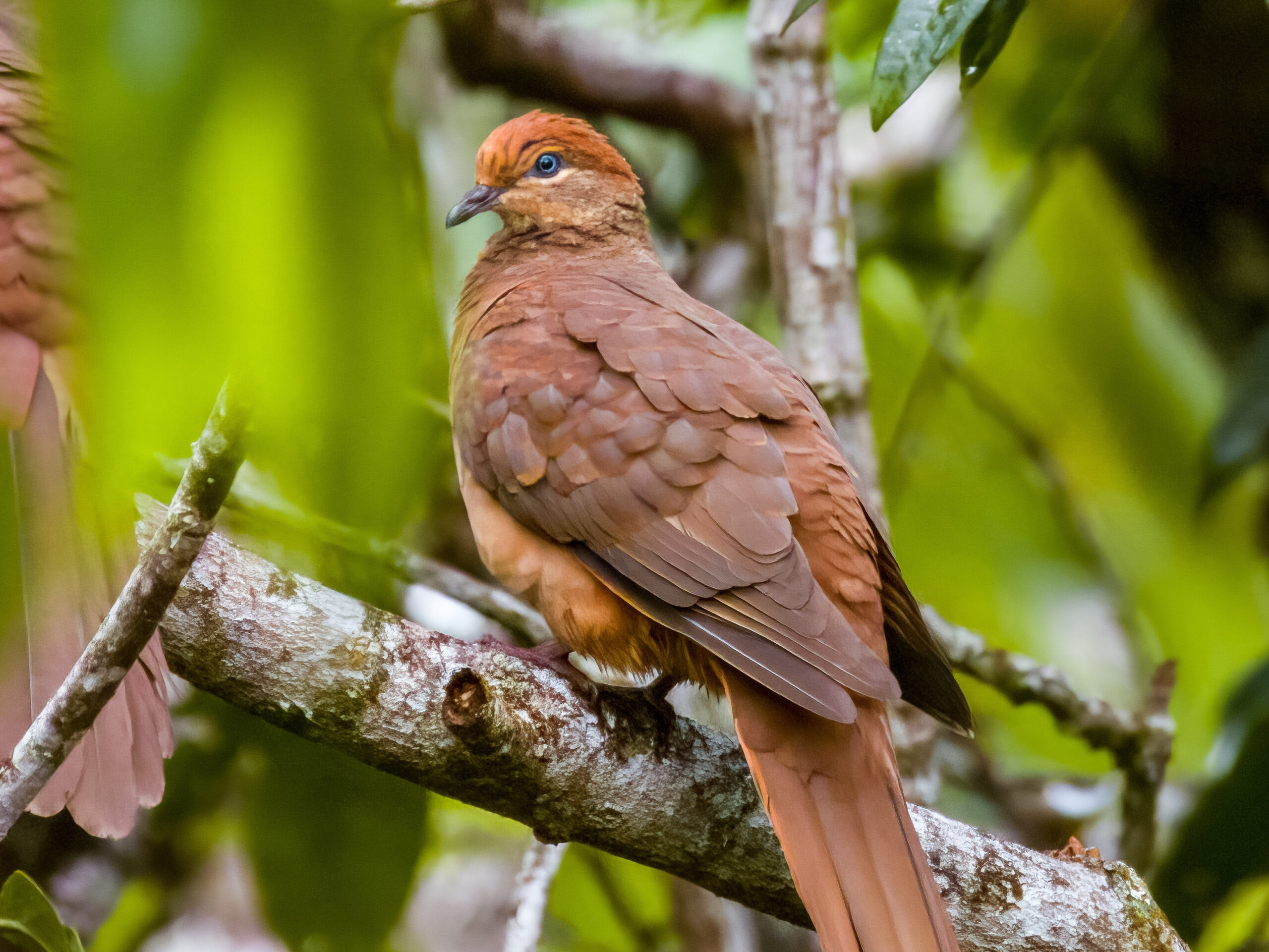Gracefully gliding through the canopies of subtropical and tropical forests, the Brown Cuckoo-Dove (Macropygia phasianella) is one of Australia’s most elegant and elongated pigeons. Its rich, cinnamon-brown plumage and long tapering tail set it apart from other native doves. Often seen in pairs or small groups, this shy yet widespread bird is a familiar sight in forested habitats along the east coast of Australia, where its slow, deliberate flight and deep cooing calls lend a tranquil presence to the landscape.
Identification
The Brown Cuckoo-Dove is a medium-sized pigeon, notable for its exceptionally long tail which makes up nearly half of its total body length. Adults measure around 40-43 cm from head to tail. Its plumage is uniformly rich brown, with a subtle pinkish or purplish sheen on the head, neck and breast. The long tail is graduated and darkens toward the tip. The eyes are reddish and the bill and legs are dull grey to dark slate. Females and juveniles may appear slightly duller than adult males. Its flight is strong but unhurried, with characteristic wing claps upon take-off.
Habitat and Distribution
Found along the east coast of Australia, from Cape York Peninsula in Queensland down to southern New South Wales, the Brown Cuckoo-Dove inhabits subtropical and tropical rainforests, wet sclerophyll forests and dense regrowth or riparian areas. It is often observed near forest edges and clearings, especially where fruit-bearing native shrubs and trees are abundant. The species is adaptable and sometimes extends into semi-urban bushland and well-vegetated gardens near natural forests.
Ecological Role
As a frugivorous bird, the Brown Cuckoo-Dove plays an essential role in seed dispersal within its habitat. Feeding on a wide variety of native and introduced fruits, it helps propagate rainforest plant species over broad distances. Its gizzard is relatively weak, meaning seeds often pass through unharmed and are deposited in new locations via droppings. This supports forest regeneration and biodiversity, particularly in disturbed or recovering areas. The species also serves as prey for raptors and large snakes, contributing to the broader food web.
Behaviour and Reproduction
Generally solitary or in pairs, Brown Cuckoo-Doves may form loose flocks when feeding on abundant fruiting trees. Their call is a loud, repetitive “whoop-whoop-whoop,” often heard in the early morning or late afternoon. Breeding can occur year-round in favourable climates, with peaks in spring and summer. The nest is a simple platform of sticks, built in the fork of a tree or dense vine tangle. One white egg is laid per clutch, with both parents sharing incubation and chick-rearing duties. The chick fledges within about two weeks.
Conservation Status
In Queensland, Macropygia phasianella is listed as Least Concern under the Nature Conservation Act 1992. It is also considered Least Concern in Western Australia, though it does not naturally occur in the state and is instead restricted to the eastern seaboard. Its wide distribution and adaptability to modified habitats contribute to its stable conservation status across much of its range.
Threats
The Brown Cuckoo-Dove is generally resilient and not currently considered at risk. However, localised threats include habitat fragmentation due to land clearing, particularly in areas where rainforest remnants are under pressure from development or agriculture. Introduced predators such as cats may prey on adults and chicks near human settlements. Additionally, the loss of fruiting understorey plants and invasive weed species can affect food availability. Climate change may also influence the distribution of fruiting trees and overall forest health.
Conservation Efforts
While not the focus of specific conservation programs, the Brown Cuckoo-Dove benefits from broader efforts aimed at rainforest preservation, reforestation and weed management. Maintaining habitat corridors and promoting the growth of native fruit-bearing shrubs and trees in both conservation areas and private gardens can support its population. Public awareness of the species’ ecological importance is also increasing through birdwatching and citizen science projects such as eBird and BirdLife Australia’s surveys.
Final Thoughts
The Brown Cuckoo-Dove is a striking emblem of Australia’s eastern forests – a gentle, steady presence whose role in forest regeneration is as valuable as its aesthetic grace. With its unhurried flight and soft calls, it serves as a reminder of the quiet resilience of native birdlife and the importance of preserving the complex ecosystems that support them. Protecting this species ensures the ongoing vitality of the forests it calls home and the countless species that depend on those green sanctuaries.
Fauna Resources specialises in the safe handling of a range of different fauna species, through safe, effective and ethical fauna solutions. By providing dedicated fauna services, through passionate fauna spotter catchers and fauna specialists, we can support the unique terrestrial ecosystems and rich biodiversity Australia has to offer.
For more information about our specialist fauna services contact Fauna Resources today.

